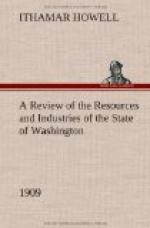The third method is in securing the water by means of artesian wells. This method is naturally limited to small areas, the projects being undertaken by individual private owners. Several spots have been found in the arid belt where this method is successful.
SOILS.
The soils over the entire areas of eastern Washington on the arid lands is a volcanic ash mixed with disintegrated basaltic rocks and some humus, varying in depth and in the amount of sand it contains. The low lands are usually more sandy and warmer and earlier in season. The depth of this soil is in some places 80 feet and generally so deep as to insure great permanency to its fertility. It readily absorbs and holds moisture, and is admirably adapted to artificial watering. In some spots there is an injurious surplus of alkali. It is generally covered with sagebrush and has the appearance of sterility, but upon cultivation under irrigation, produces wonderful results in quantity and quality of grains and grasses and fruits and vegetables.
GRAINS.
Wheat, oats and corn are successfully grown, but not in large acreage, because larger profits can be realized from other crops.
HOPS AND POTATOES.
Hops, for example, which can be produced at a cost of 7-1/2 cents per pound, yield from 1,500 to 2,000 pounds per acre, and potatoes, yielding from 300 to 500 bushels per acre, and receiving the highest market price, are both more profitable than wheat or oats.
[Page 43] alfalfa.
Alfalfa, yielding from eight to ten tons per acre, and commanding from $6.00 to $12.00 per ton, is a very profitable crop. Much wheat and oats are cut when in the milk and sold for hay, and yield better returns than when matured and threshed.
FRUITS.
The smaller fruits are very profitable under irrigation, yielding from $300 to $500 net per acre, while apples, pears, peaches, grapes, etc., often far exceed these figures, sometimes yielding as much as $1,000 per acre net.
Dairying.
Dairying is extensively followed on the irrigated lands, particularly in Kittitas county, where the cool atmosphere is very favorable, and the farmers find that turning timothy and clover, alfalfa and grain hay into butter fat is more profitable than wheat-raising.
PREPARATION OF LAND.
There is a good deal of this arid land which will have to be freed from the sagebrush and smoothed over before it will be fit for irrigation. This expense, together with building headgates and lateral ditches, building flumes and seeding to alfalfa, will cost from $15.00 to $20.00 per acre, depending upon the character of the surface, the size of the sagebrush, and amount of flumes, etc. Some, however, very smooth lands can be prepared for seeding at less expense.




